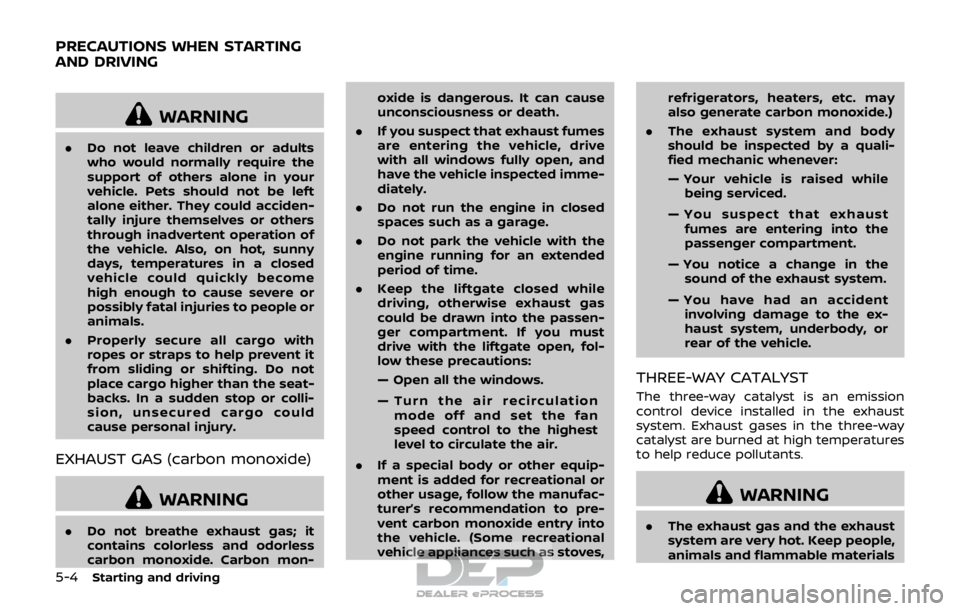NISSAN ROGUE SPORT 2017 Owners Manual
Manufacturer: NISSAN, Model Year: 2017, Model line: ROGUE SPORT, Model: NISSAN ROGUE SPORT 2017Pages: 512, PDF Size: 3.33 MB
Page 281 of 512

4-102Heater, air conditioner, audio and phone systems
rectly.
. Wait until a tone sounds before speak-
ing a command. Otherwise, the com-
mand will not be received properly.
. Start speaking a command within 3.5
seconds after the tone sounds.
. Speak in a natural voice without
pausing between words.
JVH1687X
SYSTEM FEATURES
NISSAN Voice Recognition can activate
the following systems:
.Phone
. Navigation
. Audio
. Information
. My Apps
. Help
For additional information on the naviga-
tion system, see the separate Navigation
System Owner’s Manual.
How to say numbers
NISSAN Voice Recognition requires a
certain way to speak numbers in voice
commands. Refer to the following exam-
ples.
General rule: Either “zero” or “oh” can be
used for “0”.
Phone numbers:
Speak phone numbers according to the
following example. For 1-800-662-6200,
say dial number and then speak the
phone number in any of the following
formats:
. “one eight oh oh six six two six two oh
oh”
. “one eight hundred six six two six two
oh oh”
. “one eight zero zero six six two six two
oh oh”
For the best voice recognition phone
dialing results, say phone numbers as
single digits. Also, full numbers can only
be spoken for “800”. For example, you
cannot say 555-6000 as “five five five six
thousand”.
Page 282 of 512

PHONE VOICE COMMANDS
To access the phone voice commands:
1. Push the
button.
2. Say “Call” and then a name in the phonebook to call that entry. Other-
wise, say “Phone” to access various
phone commands.
If the Bluetooth® has been set to “OFF”,
the system announces: “Bluetooth® is off.
Would you like to turn Bluetooth® on?”
If no phone is connected to the system
and the vehicle is stationary, the system
announces: “There is no phone con-
nected. Would you like to connect a
phone now?” Say “Yes” to connect a
phone. All further phone voice commands
are only available if a phone is connected.
If a phone is connected and Bluetooth® is
set to “ON”, the following voice com-
mands are available:
. Call (a name)
Speak the name of the contact in
which you are trying to call. System
will confirm correct contact. Say “Dial”
to initiate dialing.
. Dial Number
Allows for up to 24 digits to be dialed.
After the number is entered, say “Dial”
to initiate dialing. Say “Correction” to
correct the number entered. Say “Go Back” to return to the main menu.
. List Phonebook
Starting with the first alphabetical
entry in the vehicle phonebook, the
system prompts for an additional
command. Say “Dial” to call the num-
ber of the phonebook entry. Say “Send
Text” to send a text message to the
number of the phonebook entry. Say
“Next Entry” to skip to the next alpha-
betical entry in the vehicle phonebook,
where the same options will then be
available.
. Recent Calls
The system prompts for an additional
command. Say “Missed Calls”, “Incom-
ing Calls” or “Outgoing Calls” to display
a list of such calls on the screen.
Speak the number of the entry dis-
played on the screen to dial that
number or say “Next Page” to view
entries on the next page (if available).
. Redial
Redials the last called number.
. Read Text (if so equipped)
Reads an incoming text message. For
more information about text messa-
ging with the Bluetooth® Hands-Free
Phone System, see “Text messaging”
(P.4-97). .
Send Text (if so equipped)
Sends a text message. For more
information about text messaging
with the Bluetooth® Hands-Free
Phone System, see “Text messaging”
(P.4-97).
. Select Phone
The system replies “Please use manual
controls to continue”. Use manual
controls to change the active phone
from among the listed phones con-
nected to the vehicle.
. Siri (if so equipped)
Siri® Eyes Free function can be acti-
vated. See “Siri® Eyes Free” (P.4-79) for
details.
For more information about the Blue-
tooth® Hands-Free Phone System, see
“Bluetooth® Hands-Free Phone System
(models with navigation system)” (P.4-93).
NAVIGATION SYSTEM VOICE COM-
MANDS
The following voice commands are avail-
able for the Navigation System:
. Street Address (address)
. Points of Interest (name)
. POI by Category
. Home
. Address Book
Heater, air conditioner, audio and phone systems4-103
Page 283 of 512

4-104Heater, air conditioner, audio and phone systems
.Previous Destinations
. Enter Address in Steps
. Cancel Route
For more information about these com-
mands, see the separate Navigation Sys-
tem Owner’s Manual.
AUDIO SYSTEM VOICE COMMANDS
To access the audio system voice com-
mands:
1. Push the
button.
2. Say “Audio”.
3. Speak a command from the following available commands:
. Play (AM, FM, etc.)
Allows user to select radio band
. Tune AM (number)
Allows user to tune directly to a
desired AM frequency
. Tune FM (number)
Allows user to tune directly to a
desired FM frequency
. SXM Channel (number)
Allows user to tune directly to a
desired SXM channel (if so equipped)
. CD Track (number)
Allows user to select track to be
played
. Play Song (name)
Allows user to select song name to be played
. Play Artist (name)
Allows user to select artist to be
played
. Play Album (name)
Allows user to select album name to
be played
For more information about the audio
system, see “FM-AM-SAT radio with Com-
pact Disc (CD) player (Type B)” (P.4-63).INFORMATION VOICE COMMANDS
The following voice commands are avail-
able for the information functions of the
Navigation System:
. Traffic
. Fuel Prices
. Sports
. Stocks
. Movie Listings
. Current Weather
. Weather Map
. 5-day Forecast
. 6-hour Forecast
. Connect To Voice Menu (if so
equipped)
For more information about these com-
mands, see the separate Navigation Sys-
tem Owner’s Manual.
MY APPS VOICE COMMANDS
Many Apps can be accessed using this
voice command. For information about
smartphone integration, “NissanCon-
nect
SMMobile Apps smartphone integra-
tion” (P.4-78).
HELP VOICE COMMANDS
The following voice commands can be
spoken to have the system provide in-
structions and tips for using the NISSAN
Voice Recognition system.
. List Commands
. What Can I Say?
. General Help
. Quit
. Exit
. Help
TROUBLESHOOTING GUIDE
The system should respond correctly to
all voice commands without difficulty. If
problems are encountered, follow the
solutions given in this guide for the
appropriate error. Where the solutions
are listed by number, try each solution in
turn, starting with number one, until the
problem is resolved.
Page 284 of 512

Symptom/error messageSolution
The system responds “Com-
mand Not Recognized” or the
system fails to recognize the
command correctly. 1. Ensure that the command format is valid. Use the “List Commands” or “What Can I Say?” command under the
“Help” menu.
2. Speak clearly without pausing between words and at a level appropriate to the ambient noise level.
3. Ensure that the ambient noise level is not excessive (for example, with the windows open or the defroster on).
NOTE:
If it is too noisy to use the phone, it is likely that voice commands will not be recognized.
4. If optional words of the command have been omitted, then the command should be tried with these in place.
Heater, air conditioner, audio and phone systems4-105
Page 285 of 512

4-106Heater, air conditioner, audio and phone systems
MEMO
Page 286 of 512

5 Starting and driving
Precautions when starting and driving ...................... 5-4Exhaust gas (carbon monoxide) ................................ 5-4
Three-way catalyst ............................................................... 5-4
Tire Pressure Monitoring System (TPMS) ........... 5-5
Avoiding collision and rollover .................................... 5-8
On-pavement and off-road
driving precautions .............................................................. 5-8
Off-road recovery .................................................................. 5-9
Rapid air pressure loss ...................................................... 5-9
Drinking alcohol/drugs and driving ..................... 5-10
Driving safety precautions .......................................... 5-10
Ignition switch (models without Intelligent
Key system) ........................................................................\
............ 5-12
Continuously Variable
Transmission (CVT) ............................................................ 5-13
Manual Transmission (MT) ........................................... 5-13
Key positions ........................................................................\
.. 5-14
Push-button ignition switch (model with
Intelligent Key system) .......................................................... 5-14 Operating range for engine start function ...... 5-14
Push-button ignition switch operation ............. 5-15
Push-button ignition switch positions .............. 5-16
Emergency engine shut off ........................................ 5-16
Intelligent Key battery discharge ........................... 5-17
Before starting the engine ................................................. 5-17 Starting the engine (model without Intelligent
Key system) ........................................................................\
........... 5-18
Starting the engine (model with Intelligent
Key system) ........................................................................\
........... 5-19
Remote engine start (if so equipped) .............. 5-20
Driving the vehicle ................................................................... 5-20
Continuously Variable
Transmission (CVT) ......................................................... 5-20
Manual Transmission (MT) ........................................ 5-25
Parking brake ........................................................................\
....... 5-27
Pedal type ........................................................................\
....... 5-27
Switch type (models with electronic
parking brake system) ................................................. 5-27
ECO mode system ................................................................... 5-29 ECO Pedal Guide function ......................................... 5-30
Ambient ECO ........................................................................\
5-30
ECO Drive Report .............................................................. 5-31
Lane Departure Warning (LDW) (if
so equipped) ........................................................................\
......... 5-32 LDW system operation ................................................. 5-33
How to enable/disable the LDW system ....... 5-34
LDW system limitations ............................................... 5-35
System temporarily unavailable ........................... 5-36
System malfunction ....................................................... 5-36
System maintenance .................................................... 5-36
Page 287 of 512

Intelligent Lane Intervention (I-LI) (if
so equipped) ........................................................................\
.......... 5-37I-LI system operation ....................................................... 5-38
How to enable/disable the I-LI system ............. 5-39
I-LI system limitations ..................................................... 5-39
System temporarily unavailable ............................. 5-41
System malfunction .......................................................... 5-41
System maintenance ....................................................... 5-42
Blind Spot Warning (BSW) (if so equipped) ........... 5-42 BSW system operation ................................................... 5-44
How to enable/disable the BSW system .......... 5-45
BSW system limitations .................................................. 5-46
BSW driving situations .................................................... 5-47
System temporarily unavailable ............................. 5-50
System malfunction .......................................................... 5-51
System maintenance ....................................................... 5-51
Rear Cross Traffic Alert (RCTA) (if
so equipped) ........................................................................\
.......... 5-52
RCTA system operation ................................................. 5-53
How to enable/disable the RCTA system ....... 5-55
RCTA system limitations ............................................... 5-56
System temporarily unavailable ............................. 5-58
System malfunction .......................................................... 5-59
System maintenance ....................................................... 5-59
Cruise control (if so equipped) ....................................... 5-60 Precautions on cruise control .................................. 5-61
Cruise control operations ............................................ 5-61 Intelligent Cruise Control (ICC) (if
so equipped) ........................................................................\
......... 5-62
How to select the cruise control mode ......... 5-64
Vehicle-to-vehicle distance
control mode ....................................................................... 5-64
Conventional (fixed speed) cruise
control mode ....................................................................... 5-78
Automatic Emergency Braking (AEB) (if
so equipped) ........................................................................\
......... 5-82 AEB system operation .................................................. 5-83
Turning the AEB system ON/OFF ....................... 5-85
AEB system limitations ................................................ 5-86
System temporarily unavailable ........................... 5-87
System malfunction ....................................................... 5-88
System maintenance .................................................... 5-88
Automatic Emergency Braking (AEB) with
pedestrian detection system .......................................... 5-89 AEB with pedestrian detection
system operation ............................................................. 5-91
Turning the AEB with pedestrian detection
system ON/OFF ................................................................. 5-93
AEB with pedestrian detection
system limitations ............................................................ 5-94
System temporarily unavailable ........................... 5-96
System malfunction ....................................................... 5-97
System maintenance .................................................... 5-98
Break-in schedule ..................................................................... 5-99
Fuel Efficient Driving Tips ................................................... 5-99
Page 288 of 512

Increasing fuel economy ................................................. 5-100
Intelligent 4x4 (if so equipped) ................................... 5-100Intelligent 4x4 LOCK switch operations ...... 5-102
Parking/parking on hills ................................................... 5-104
Electric power steering ..................................................... 5-105
Brake system ........................................................................\
.... 5-106 Braking precautions ..................................................... 5-106
Brake assist ........................................................................\
........ 5-107
Brake assist ........................................................................\
. 5-107
Anti-lock Braking System (ABS) ........................... 5-107
Vehicle Dynamic Control (VDC) system ............... 5-108
Chassis control ........................................................................\
5-110 Intelligent Trace Control ........................................... 5-110 Intelligent Engine Brake (Continuously
Variable Transmission (CVT) models) .......... 5-111
Active Ride Control ..................................................... 5-112
Hill Start Assist system ..................................................... 5-113
Cold weather driving ......................................................... 5-113 Freeing a frozen door lock ................................... 5-113
Anti-freeze ........................................................................\
.. 5-113
Battery ........................................................................\
........... 5-113
Draining of coolant water ..................................... 5-113
Tire equipment ............................................................... 5-114
Special winter equipment ..................................... 5-114
Driving on snow or ice ............................................. 5-114
Page 289 of 512

5-4Starting and driving
WARNING
.Do not leave children or adults
who would normally require the
support of others alone in your
vehicle. Pets should not be left
alone either. They could acciden-
tally injure themselves or others
through inadvertent operation of
the vehicle. Also, on hot, sunny
days, temperatures in a closed
vehicle could quickly become
high enough to cause severe or
possibly fatal injuries to people or
animals.
. Properly secure all cargo with
ropes or straps to help prevent it
from sliding or shifting. Do not
place cargo higher than the seat-
backs. In a sudden stop or colli-
sion, unsecured cargo could
cause personal injury.
EXHAUST GAS (carbon monoxide)
WARNING
.Do not breathe exhaust gas; it
contains colorless and odorless
carbon monoxide. Carbon mon- oxide is dangerous. It can cause
unconsciousness or death.
. If you suspect that exhaust fumes
are entering the vehicle, drive
with all windows fully open, and
have the vehicle inspected imme-
diately.
. Do not run the engine in closed
spaces such as a garage.
. Do not park the vehicle with the
engine running for an extended
period of time.
. Keep the liftgate closed while
driving, otherwise exhaust gas
could be drawn into the passen-
ger compartment. If you must
drive with the liftgate open, fol-
low these precautions:
— Open all the windows.
— Turn the air recirculation
mode off and set the fan
speed control to the highest
level to circulate the air.
. If a special body or other equip-
ment is added for recreational or
other usage, follow the manufac-
turer’s recommendation to pre-
vent carbon monoxide entry into
the vehicle. (Some recreational
vehicle appliances such as stoves, refrigerators, heaters, etc. may
also generate carbon monoxide.)
. The exhaust system and body
should be inspected by a quali-
fied mechanic whenever:
— Your vehicle is raised while
being serviced.
— You suspect that exhaust fumes are entering into the
passenger compartment.
— You notice a change in the sound of the exhaust system.
— You have had an accident involving damage to the ex-
haust system, underbody, or
rear of the vehicle.
THREE-WAY CATALYST
The three-way catalyst is an emission
control device installed in the exhaust
system. Exhaust gases in the three-way
catalyst are burned at high temperatures
to help reduce pollutants.
WARNING
. The exhaust gas and the exhaust
system are very hot. Keep people,
animals and flammable materials
PRECAUTIONS WHEN STARTING
AND DRIVING
Page 290 of 512

away from the exhaust system
components.
. Do not stop or park the vehicle
over flammable materials such as
dry grass, wastepaper or rags.
They may ignite and cause a fire.
CAUTION
.Do not use leaded gasoline. De-
posits from leaded gasoline will
seriously reduce the three-way
catalyst’s ability to help reduce
exhaust pollutants.
. Keep your engine tuned up. Mal-
functions in the ignition, fuel in-
jection, or electrical systems can
cause overrich fuel flow into the
three-way catalyst, causing it to
overheat. Do not keep driving if
the engine misfires, or if notice-
able loss of performance or other
unusual operating conditions are
detected. Have the vehicle in-
spected. It is recommended you
visit a NISSAN dealer for this
service.
. Avoid driving with an extremely
low fuel level. Running out of fuel
could cause the engine to misfire, damaging the three-way catalyst.
. Do not race the engine while
warming it up.
. Do not push or tow your vehicle
to start the engine.
TIRE PRESSURE MONITORING SYS-
TEM (TPMS)
Each tire, including the spare (if provided),
should be checked monthly when cold
and inflated to the inflation pressure
recommended by the vehicle manufac-
turer on the vehicle placard or tire infla-
tion pressure label. (If your vehicle has
tires of a different size than the size
indicated on the vehicle placard or tire
inflation pressure label, you should deter-
mine the proper tire inflation pressure for
those tires.)
As an added safety feature, your vehicle
has been equipped with a Tire Pressure
Monitoring System (TPMS) that illumi-
nates a low tire pressure telltale when
one or more of your tires is significantly
under-inflated. Accordingly, when the low
tire pressure telltale illuminates, you
should stop and check your tires as soon
as possible, and inflate them to the
proper pressure. Driving on a significantly
under-inflated tire causes the tire to
overheat and can lead to tire failure. Under-inflation also reduces fuel effi-
ciency and tire tread life, and may affect
the vehicle’s handling and stopping abil-
ity.
Please note that the TPMS is not a
substitute for proper tire maintenance,
and it is the driver’s responsibility to
maintain correct tire pressure, even if
under-inflation has not reached the level
to trigger illumination of the TPMS low
tire pressure telltale.
Your vehicle has also been equipped with
a TPMS malfunction indicator to indicate
when the system is not operating prop-
erly. The TPMS malfunction indicator is
combined with the low tire pressure tell-
tale. When the system detects a malfunc-
tion, the telltale will flash for
approximately one minute and then re-
main continuously illuminated. This se-
quence will continue upon subsequent
vehicle start-ups as long as the malfunc-
tion exists. When the malfunction indica-
tor is illuminated, the system may not be
able to detect or signal low tire pressure
as intended. TPMS malfunctions may
occur for a variety of reasons, including
the installation of replacement or alter-
nate tires or wheels on the vehicle that
prevent the TPMS from functioning prop-
erly. Always check the TPMS malfunction
telltale after replacing one or more tires
Starting and driving5-5